Book Review
The Dravidian Model: Interpreting the Political Economy of Tamil Nadu.
By Kalaiyarasan A. and Vijaybaskar M. Cambridge University Press, 2021.
This was a book waiting to happen. State-based ‘models’ of development have been talked about for decades, beginning with the Punjab-Haryana green revolution model; the different social engineering models offered by states like Maharashtra, Bihar and Karnataka in the 1970s; through the long-discussed Kerala model to the more recent Gujarat model. In fact, Tamil Nadu has been the site of so much social science research since at least the 1960s – in demography, economics, history, political science, social anthropology and sociology – that it is surprising a synthesising ‘model’ took so long to appear.
But on second thoughts, this may not be so surprising. The very existence of a rich literature on the economic, social, political, and cultural aspects of Tamil Nadu’s recent history raises the bar for any integrated story. Too much is known about the state’s very different sub-regions, its distinctive agrarian and industrial commodity systems, and the specificities of the various phases of its history to allow any synthesising effort to claim an easy victory. The stakes are raised even higher when the word ‘model’ is applied to the synthesis. Whether in its specifically economic sense as a selective, stylised structure meant to achieve some theoretical aim, or in its stronger ordinary language sense of something like an example to be emulated or a norm of some kind, a model is not just any ordinary story.
Culmination of research
That The Dravidian Model presents a credible case in the face of these odds is no mean achievement, and its authors, Kalaiyarasan A. and Vijaybaskar M. (henceforth KV), have much to be proud of. The subtitle – Interpreting the political economy of Tamil Nadu – is quite accurate because the book is essentially an innovative interpretation of known facts and data. In terms of its immediate intellectual lineage, the book can be seen as the culmination of a half-century of development studies research on Tamil Nadu beginning with Malcolm Adiseshiah’s Perspective Plan for Tamil Nadu published by the state’s Planning Commission in 1972. The book also bears the imprint – warmly acknowledged – of the thought of the late M.S.S. Pandian (a maverick scholar who started out in economics and trespassed productively into the other social sciences), particularly his germinal work Brahmin and Non-Brahmin: Genealogies of the Tamil Political Present (2007). It is no surprise, therefore, that both authors are affiliated to the Madras Institute of Development Studies in Chennai, the institution that Adiseshiah founded and where Pandian was a faculty member for more than a decade.
The eight chapters cover 230 pages, and include 43 tables and 15 figures, as might be expected of a book whose main purpose is to showcase and explain Tamil Nadu’s development trajectory. Five of the eight chapters (Chapters 3−7) are devoted to providing evidence to back this claim. They cover the subjects of education, health care, growth-friendly infrastructure development and incentives for broad-based entrepreneurship, the transformation of rural relations, popular schemes for cities and towns, and programmes for urban labour. According to KV, the distinctiveness of Tamil Nadu’s achievement is that it has delivered social justice and human development along with sustained economic growth. This is in contrast to states like Kerala and Himachal Pradesh (which have done well on development but not on growth) or Gujarat and Maharashtra (which have grown fast but have not done as well on the inclusive development front).
While the empirics of Tamil Nadu’s development history are familiar from prior research, KV’s innovation is in the theoretical framework built to explain this trajectory – the ‘Dravidian model’. KV write that they “use the term ‘model’ […] to open the field of subnational studies and to generate questions on the links between development and caste based mobilisation” (13). Chapter 2 (‘Conceptualising power in caste society’) is the heart of the book for this is where the mechanism of the model is detailed. KV argue – on the whole successfully – for the constitutive (rather than merely influential) role of caste-based movements in shaping both the polity and the economy of Tamil Nadu. They draw extensively from the recent literature on populism, particularly the strand of argument that goes from Antonio Gramsci to Ernesto Laclau, Chantal Mouffe and, closer to home, works like Partha Chatterjee’s I am the People (2019).
Central idea
The central idea is that the anti-Brahmin movement – which developed into the Self-Respect Movement – became the site for the construction of an inclusive Dravidian identity that could build a “chain of equivalences” across various caste groups. This is what prevented the swift splintering of lower caste alliances after initial successes in challenging upper caste political power, as seen in states like Bihar.
By articulating its demands in the language of dignity and self-respect, the Dravidian movement constructed a “historic bloc”: a broad coalition of disparate class-caste groups and communities. This enabled the movement to become hegemonic by fashioning a “Dravidian common sense,” a popular ideology that secured not just the consent but the active participation of the people. By avoiding the language of class and identifying the “Aryan-brahmin” as the enemy, the Dravidian movement created the space for a political formation that could simultaneously pursue capitalist growth and social-democratic welfare. The result is that today Tamil Nadu is a state that has the highest rate of urbanisation, one-fourth of all Dalit enterprises in the nation, highest gross enrolment ratio in higher education (both overall and for Scheduled Castes), one of the highest rates for both poverty reduction and economic growth, and the highest share of renewable energy.
The concluding chapter ( ‘Fissures, limits and possible futures’) is the second most important part of the book, for it maps the boundaries and vulnerabilities of the Dravidian model. The remarkable hegemonic run of a pan-Dravidian-Tamil identity is now challenged by growing inequalities, some built on existing disparities and others arising from the very success of the model. Rural-urban divisions are sharpening and urban inequality is on the rise. Public services, once responsive to popular needs, are reaching the limits of their sustainability. The increased privatisation of education and health care has lead to wide disparities in quality, with a consequent impact on equity. The tide of populist politics has turned from enabling participation to abetting cronyism. (Tamil Nadu has high rates of corruption as well as the highest average election spending per constituency in state elections.)
Perhaps the most significant development is the emergence of sharp intra- and inter-caste divisions. Tamil Nadu has seen some of the most violent and intense confrontations between locally dominant castes and Dalits. There are also the limitations imposed by an increasingly constrictive federalism tilted towards the centre, and the inevitable pressure of a predatory Hindu-right populism that seems to be headed towards hegemony in most of the nation.
Adding to the repertoire
Any claim to ploughing a new furrow in what is already a well-cultivated field must inevitably rely on some amount of over- and under-statement, and so it is with The Dravidian Model. But in the final analysis, this counts as an honest book. Proof of this is provided by the fact that the book reads very differently if one begins with the last chapter than it does than when one starts in the usual way.
KV’s main contribution is not so much in providing an explanation for Tamil Nadu’s development trajectory as in adding to the repertoire of method in political economy in two important ways. The most significant achievement of The Dravidian Model is in highlighting the methodological implications of caste for political economy in India. Caste is at one and the same time the principal modality for regulating access to political, cultural, and economic capital. As such, it plays a constitutive role in shaping the trajectories of the processes that we label as ‘development’ or ‘democracy’ – indeed, it is in large part the very surface on which these processes are inscribed. The long-standing struggle to ‘integrate’ the social, the political, and the economic — which is the founding impulse of political economy — is continually challenged and thwarted by the limitations of our methods. This book takes an incremental step forward in this struggle, even as it invites productive critiques.
A second accomplishment of this volume is the renewed focus it brings to bear on the question of – for want of a better word – ‘scale’ in political economy. The challenge is not just of geo-physical or juridical boundaries, but of the space necessary for the coherent intermeshing of the distinct loci of political accountability, economic interdependency, and cultural belonging. As is well known, the social sciences are modern disciplines whose history is inextricably enmeshed with that of the nation-state. The more or less arbitrary borders of the latter have provided the implicit and explicit methodological demarcations for ‘areas’ that are then worked upon by researchers within a given academic-institutional framework. The notion of scale is unable to capture the fundamental circularity that is at stake. Here, the size of the canvas determines not only the dimensions of the painting but also its content and even its style. Even if it is unable to provide definitive answers, The Dravidian Model raises once again the question of what becomes visible at different levels of analysis below the nation-state, and, conversely, the space required to render particular processes legible.
This was a book waiting to be written. Now that it is written, it awaits our critical engagement.
(Satish Deshpande teaches sociology at the University of Delhi. Courtesy: The India Forum. The India Forum is an independent online journal-magazine that seeks to widen and deepen our conversations on the issues that concern people.)




